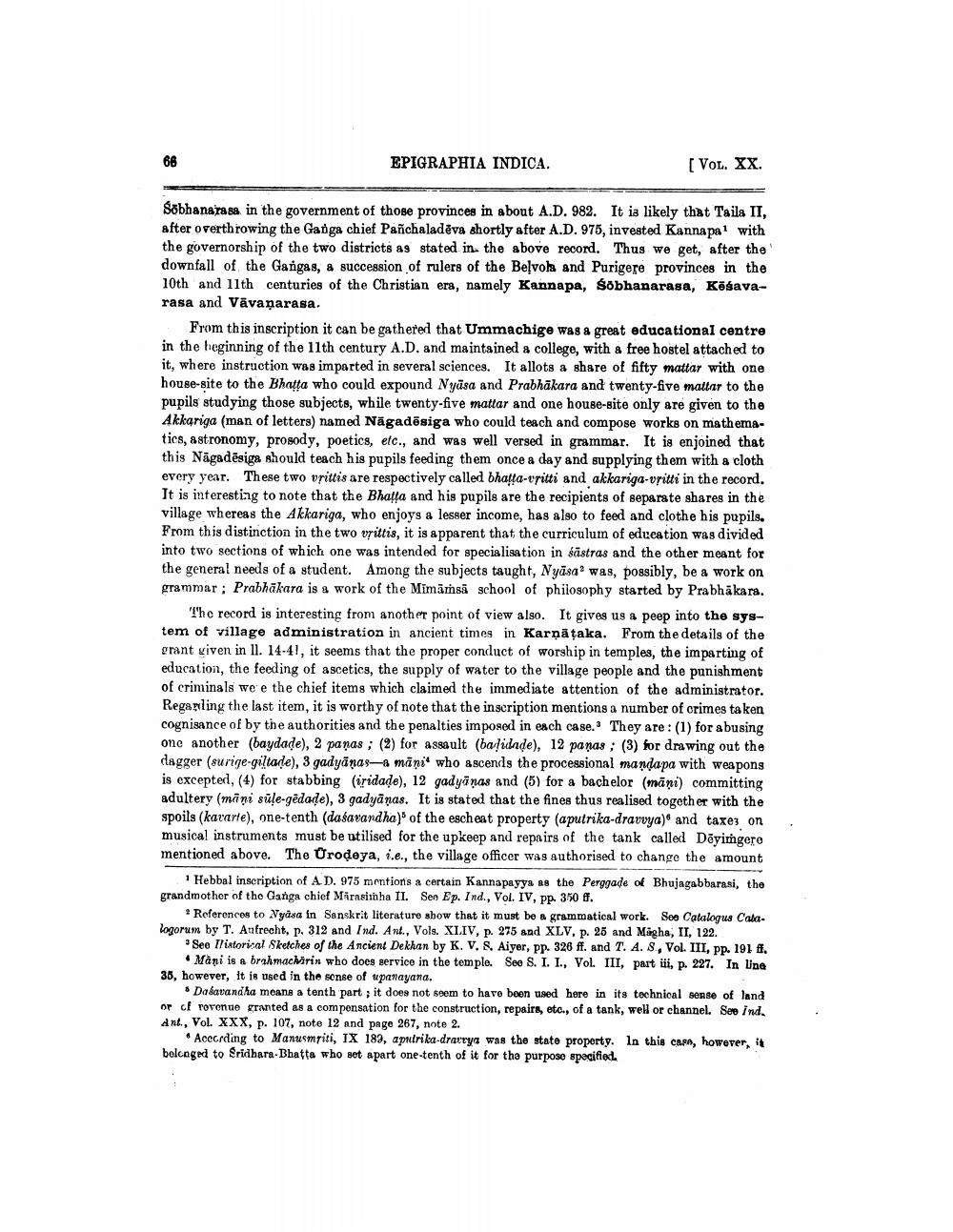________________
EPIGRAPHIA INDICA.
[Vol. XX.
Sobhanara sa in the government of those provinces in about A.D. 982. It is likely that Taila II, after overthrowing the Ganga chief Panchaladēva shortly after A.D. 975, invested Kannapa! with the governorship of the two districts as stated in the above record. Thus we get, after the downfall of the Gangas, a succession of rulers of the Beļvola and Purigere provinces in the 10th and 11th centuries of the Christian era, namely Kannapa, Sobhanarasa, Köśavarasa and Vāvanarasa.
From this inscription it can be gathered that Ummachige was a great educational centre in the beginning of the 11th century A.D. and maintained a college, with a free hostel attached to it, where instruction was imparted in several sciences. It allots a share of fifty mattar with one house-site to the Bhata who could expound Nyāsa and Prabhākara and twenty-five mallar to the pupils studying those subjects, while twenty-five mattar and one house-site only are given to the Akkariga (man of letters) named Nāgadēsiga who could teach and compose works on mathematics, astronomy, prosody, poetics, etc., and was well versed in grammar. It is enjoined that this Nāgadēsiga should teach his pupils feeding them once a day and supplying them with a cloth every year. These two vrittis are respectively called bhatta-esitti and akkariga-vritti in the record. It is interesting to note that the Bhatta and his pupils are the recipients of separate shares in the village whereas the Akkariga, who enjoys a lesser income, has also to feed and clothe his pupils, From this distinction in the two vrittis, it is apparent that the curriculum of education was divided into two sections of which one was intended for specialisation in bästras and the other meant for the general needs of a student. Among the subjects taught, Nyāsa? was, possibly, be a work on grammar: Prabhākara is a work of the Mimämsä school of philosophy started by Prabhākara.
The record is interesting from another point of view also. It gives us & peep into the system of village administration in ancient times in Karnataka. From the details of the grant viven in II. 14-41, it seems that the proper conduct of worship in temples, the imparting of education, the feeding of ascetics, the supply of water to the village people and the punishment of criminals we e the chief items which claimed the immediate attention of the administrator. Regagling the last item, it is worthy of note that the inscription mentions a number of crimes taken cognisance of by the authorities and the penalties imposed in each case. They are: (1) for abusing one another (baydade), 2 panas ; (2) for assault (balidade), 12 panas ; (3) for drawing out the dagger (surige-gillade), 3 gadyānas-mani' who ascends the processional mandapa with weapons is excepted, (4) for stabbing (iridade), 12 gadyānas and (5) for a bachelor (mäni) committing adultery (mini süle-gēdade), 3 gadyānas. It is stated that the fines thus realised together with the spoils (kararle), one-tenth (dasavandha) of the escheat property (aputrika-dravvya) and taxes on musical instruments must be utilised for the upkeep and repairs of the tank called Döyimgere mentioned above. The Urodeya, i.e., the village officer was authorised to change the amount
Hebbal inscription of A D. 975 mentions a certain Kannapayys as the Perggade of Bhujagabbarasi, the grandmother of the Ganga chief Marasimha II. Sen Ep. Ind., Vol. IV, Pp. 350 .
References to Nyasa in Sanskrit literature show that it must be a grammatical work. Son Catalogus Calalogorum by T. Aufrecht, p. 312 and Ind. Ant., Vols. XLIV, p. 275 and XLV. p. 25 and Migha, II, 122.
See Il intorical Sketches of the Ancient Dekhan by K. V. & Aiyer, pp. 326 ff. and T. A. 8, Vol. III, pp. 191 fl.
• Mani is a brahmachirin who does service in the temple. See 8. I. I., Vol. III, part iii, p. 227. In Una 30, however, it is used in the sense of spanayana.
. Dabavandha moana a tenth part; it does not seem to have been tised here in its technical sense of land or el rovenue granted as a compensation for the construction, repairs, etc., of a tank, well or channel. See ind ant., Vol. XXX, p. 107, note 12 and page 267, note 2.
• According to Manusmriti, IX 182, aptrika-drarrya was the state property. In this carn, however, it bolcaged to Sridhara-Bhatta who set apart one-tenth of it for the purpose specified




